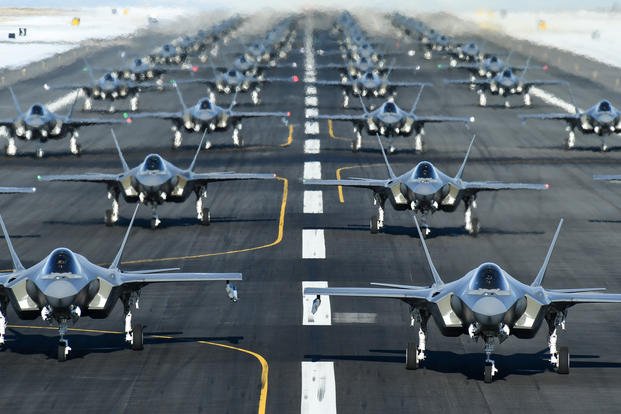The chairman of the House Armed Services Committee is questioning how the F-35 Joint Strike Fighter program fits into the Defense Department's future strategy, likening the Pentagon's most expensive program to date to "throwing money down that particular rathole."
"What does the F-35 give us?" Rep. Adam Smith, D-Wash., asked during a virtual Brookings Institution event Friday. "Is there a way to cut our losses? Is there a way to not keep spending so much money for such a low capability? Because the sustainment costs are brutal."
The F-35 program's total cost has been projected at more than $1 trillion over a 50-year service lifetime. The program has been plagued with breakdowns -- including engine fires, structural cracks, and peeling and crumbling insulation in its cooling lines. Lawmakers have also scrutinized the jet's sustainment, maintenance and supply chain management because of mismanagement and cost overruns.
Read Next: Just One 6-Pack: NAS Pensacola Limits Alcohol Sales as Discipline Problems Increase
While Smith acknowledged that Congress can't ditch the program, he wants the Pentagon to curtail its reliance on the fifth-generation platform.
"What I'm going to try to do is figure out how we can get a mix of fighter attack aircraft that's the most cost-effective -- bottom line," he said.
The U.S. Air Force is currently conducting a "TacAir study" to determine the right mix of aircraft for its future inventory and assess how "air dominance" fighter-drone concepts could fit into it.
Smith has spoken about the F-35's growing pains in the past, but also given credit to its slow but steady progress.
"The F-35 is the poster child for doing procurement the wrong way, but to the extent possible, they've cleaned up," he said in 2014.
"It will replace 90% of fighter aircraft," he said, as reported by The Washington Business Journal. "It's going forward. There's no scenario where we'd scrap it at this point."
Lockheed Martin beat out Boeing Co. for the program contract in 2001. It had to develop three versions of the jet -- one each for the Air Force, Navy and Marine Corps -- which required a retrofit to jets still under development. That led to growing costs, drawing lawmakers' attention.
Despite pushback in the early years of the program, more lawmakers have begun to show interest in maintaining or even expanding it, especially those whose districts host manufacturing facilities or bases that house the stealth jet.
In 2019, a group of Republican senators urged the Pentagon to consider expanding the program through additional foreign military sales, or FMS, to create a stronger coalition of allies. The group included Sens. Marco Rubio of Florida and Ted Cruz of Texas.
Florida is home to F-35s at Eglin Air Force Base, which is part of the service's pilot training pipeline. Then-Vice President Mike Pence announced in 2019 that F-35s will also be headed to Tyndall Air Force Base in Florida's Panhandle, beginning in 2023. And manufacturer Lockheed Martin's main assembly line is located in Fort Worth, Texas; the company also has 91 supplier locations in the state, according to its website.
"In return for all of this, the United States strengthens its security and receives a boost to American jobs, exports, and the defense industrial base," the senators said.
Weeks later, the U.S. approved Poland as a potential F-35 FMS customer.
Based on the Defense Department's growing interest in the F-15EX fourth-plus generation fighter, Connecticut Democrats Sens. Richard Blumenthal and Chris Murphy became concerned that a reduction in F-35 procurement would slow engine production. Pratt & Whitney -- now part of Raytheon Technologies -- manufactures the jet's F135 engine at facilities in East Hartford and Middletown, Connecticut.
And in February 2019, Republican Sen. John Cornyn joined Cruz, Rubio and Maine Sen. Susan Collins to sign a letter urging the DoD not to decrease F-35 procurement even as a new F-15 fighter will join the Air Force's inventory.
The letter was also signed by Republican Sen. Lisa Murkowski of Alaska, whose state includes Eielson Air Force Base, where two F-35 squadrons will be based. Eielson received its first F-35 aircraft last year.
-- Oriana Pawlyk can be reached at oriana.pawlyk@military.com. Follow her on Twitter at @oriana0214.
Related: The Air Force May Soon Be Shopping for a New Fighter Jet














